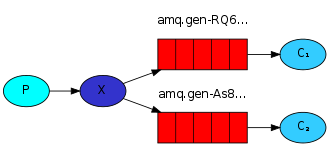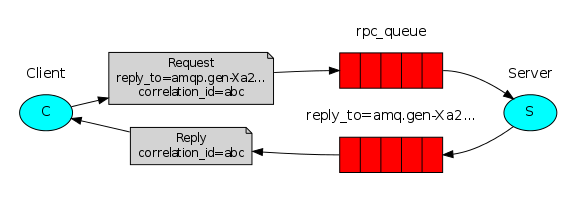python学习笔记-(十五)RabbitMQ队列
rabbitMQ是消息队列;想想之前的我们学过队列queue:threading queue(线程queue,多个线程之间进行数据交互)、进程queue(父进程与子进程进行交互或者同属于同一父进程下的多个子进程进行交互);如果两个独立的程序,那么之间是不能通过queue进行交互的,这时候我们就需要一个中间代理即rabbitMQ
消息队列:
- RabbitMQ
- ZeroMQ
- ActiveMQ
- ...........
一. 安装
1. ubuntu下安装rabbitMQ:
1.1 安装: sudo apt-get install rabbitmq-server
1.2 启动rabbitmq web服务:
sudo invoke-rc.d rabbitmq-server stop
sudo invoke-rc.d rabbitmq-server start
启动web管理:sudo rabbitmq-plugins enable rabbitmq_management
1.3 远程访问rabbitmq,自己增加一个用户,步骤如下:
- 创建一个admin用户:sudo rabbitmqctl add_user admin 123123
- 设置该用户为administrator角色:sudo rabbitmqctl set_user_tags admin administrator
- 设置权限:sudo rabbitmqctl set_permissions -p '/' admin '.' '.' '.'
- 重启rabbitmq服务:sudo service rabbitmq-server restart
之后就能用admin用户远程连接rabbitmq server了。
2. 安装python rabbitMQ modul:
- 管理员打开cmd,切换到python的安装路径,进入到Scripts目录下(如:C:\Users\Administrator\AppData\Local\Programs\Python\Python35\Scripts);
- 执行以下命令:pip install pika
- 校验是否安装成功:进入到python命令行模式,输入import pika,无报错代表成功;
二. 代码实现
1. 实现最简单的队列通信

发送端:
import pika
credentials = pika.PlainCredentials('admin', '123123')
connection = pika.BlockingConnection(pika.ConnectionParameters(
'192.168.16.82', 5672, '/', credentials))
channel = connection.channel()
#声明queue
channel.queue_declare(queue='hello')
#n RabbitMQ a message can never be sent directly to the queue, it always needs to go through an exchange.
channel.basic_publish(exchange='',
routing_key='hello',
body='Hello World!')
print(" [x] Sent 'Hello World!'")
connection.close()
接收端:
import pika
credentials = pika.PlainCredentials('admin', '123123')
connection = pika.BlockingConnection(pika.ConnectionParameters(
'192.168.16.82', 5672, '/', credentials))
channel = connection.channel()
channel.queue_declare(queue='hello')
def callback(ch, method, properties, body):
print(" [x] Received %r" % body)
channel.basic_consume(callback,
queue='hello',
no_ack=True)
print(' [*] Waiting for messages. To exit press CTRL+C')
channel.start_consuming()
2. RabbitMQ消息分发轮询
先启动消息生产者,然后再分别启动3个消费者,通过生产者多发送几条消息,你会发现,这几条消息会被依次分配到各个消费者身上

在这种模式下,RabbitMQ会默认把p发的消息公平的依次分发给各个消费者(c),跟负载均衡差不多
import pika
credentials = pika.PlainCredentials('admin', '')
connection = pika.BlockingConnection(pika.ConnectionParameters(
'192.168.16.82', 5672, '/', credentials))
channel = connection.channel() #声明一个管道(管道内发消息)
channel.queue_declare(queue='cc') #声明queue队列
channel.basic_publish(exchange='',
routing_key='cc', #routing_key 就是queue名
body='Hello World!'
)
print("Sent 'Hello,World!'")
connection.close() #关闭
publish.py
import pika
credentials = pika.PlainCredentials('admin', '')
connection = pika.BlockingConnection(pika.ConnectionParameters(
'192.168.16.82', 5672, '/', credentials))
channel = connection.channel()
channel.queue_declare(queue='cc')
def callback(ch,method,properties,body):
print(ch,method,properties)
#ch:<pika.adapters.blocking_connection.BlockingChannel object at 0x002E6C90> 管道内存对象地址
#methon:<Basic.Deliver(['consumer_tag=ctag1.03d155a851b146f19cee393ff1a7ae38', #具体信息
# 'delivery_tag=1', 'exchange=', 'redelivered=False', 'routing_key=lzl'])>
#properties:<BasicProperties>
print("Received %r"%body)
channel.basic_consume(callback, #如果收到消息,就调用callback函数处理消息
queue="cc",
no_ack=True)
print(' [*] Waiting for messages. To exit press CTRL+C')
channel.start_consuming() #开始收消息
consume.py
通过执行pubulish.py和consume.py可以实现上面的消息公平分发,那假如c1收到消息之后宕机了,会出现什么情况呢?rabbitMQ是如何处理的?现在我们模拟一下:
import pika
credentials = pika.PlainCredentials('admin', '')
connection = pika.BlockingConnection(pika.ConnectionParameters(
'192.168.16.82', 5672, '/', credentials))
channel = connection.channel() #声明一个管道(管道内发消息)
channel.queue_declare(queue='cc') #声明queue队列
channel.basic_publish(exchange='',
routing_key='cc', #routing_key 就是queue名
body='Hello World!'
)
print("Sent 'Hello,World!'")
connection.close() #关闭
publish.py
import pika,time
credentials = pika.PlainCredentials('admin', '')
connection = pika.BlockingConnection(pika.ConnectionParameters(
'192.168.16.82', 5672, '/', credentials))
channel = connection.channel()
channel.queue_declare(queue='cc')
def callback(ch,method,properties,body):
print("->>",ch,method,properties)
time.sleep(15) # 模拟处理时间
print("Received %r"%body)
channel.basic_consume(callback, #如果收到消息,就调用callback函数处理消息
queue="cc",
no_ack=True)
print(' [*] Waiting for messages. To exit press CTRL+C')
channel.start_consuming() #开始收消息
consume.py
在consume.py的callback函数里增加了time.sleep模拟函数处理,通过上面程序进行模拟发现,c1接收到消息后没有处理完突然宕机,消息就从队列上消失了,rabbitMQ把消息删除掉了;如果程序要求消息必须要处理完才能从队列里删除,那我们就需要对程序进行处理一下:
import pika
credentials = pika.PlainCredentials('admin', '')
connection = pika.BlockingConnection(pika.ConnectionParameters(
'192.168.16.82', 5672, '/', credentials))
channel = connection.channel() #声明一个管道(管道内发消息)
channel.queue_declare(queue='cc') #声明queue队列
channel.basic_publish(exchange='',
routing_key='cc', #routing_key 就是queue名
body='Hello World!'
)
print("Sent 'Hello,World!'")
connection.close() #关闭
publish.py
import pika,time
credentials = pika.PlainCredentials('admin', '')
connection = pika.BlockingConnection(pika.ConnectionParameters(
'192.168.16.82', 5672, '/', credentials))
channel = connection.channel()
channel.queue_declare(queue='cc')
def callback(ch,method,properties,body):
print("->>",ch,method,properties)
#time.sleep(15) # 模拟处理时间
print("Received %r"%body)
ch.basic_ack(delivery_tag=method.delivery_tag)
channel.basic_consume(callback, #如果收到消息,就调用callback函数处理消息
queue="cc",
)
print(' [*] Waiting for messages. To exit press CTRL+C')
channel.start_consuming() #开始收消息
consume.py
通过把consume.py接收端里的no_ack=True去掉之后并在callback函数里面添加ch.basic_ack(delivery_tag = method.delivery_tag,就可以实现消息不被处理完不能在队列里清除。
查看消息队列数:

3. 消息持久化
如果消息在传输过程中rabbitMQ服务器宕机了,会发现之前的消息队列就不存在了,这时我们就要用到消息持久化,消息持久化会让队列不随着服务器宕机而消失,会永久的保存下去
发送端:
import pika
credentials = pika.PlainCredentials('admin', '123123')
connection = pika.BlockingConnection(pika.ConnectionParameters(
'192.168.16.82', 5672, '/', credentials))
channel = connection.channel() #声明一个管道(管道内发消息)
channel.queue_declare(queue='cc',durable=True) #队列持久化
channel.basic_publish(exchange='',
routing_key='cc', #routing_key 就是queue名
body='Hello World!',
properties=pika.BasicProperties(
delivery_mode = 2 #消息持久化
)
)
print("Sent 'Hello,World!'")
connection.close() #关闭
接收端:
import pika,time
credentials = pika.PlainCredentials('admin', '123123')
connection = pika.BlockingConnection(pika.ConnectionParameters(
'192.168.16.82', 5672, '/', credentials))
channel = connection.channel()
channel.queue_declare(queue='cc',durable=True)
def callback(ch,method,properties,body):
print("->>",ch,method,properties)
time.sleep(15) # 模拟处理时间
print("Received %r"%body)
ch.basic_ack(delivery_tag=method.delivery_tag)
channel.basic_consume(callback, #如果收到消息,就调用callback函数处理消息
queue="cc",
)
print(' [*] Waiting for messages. To exit press CTRL+C')
channel.start_consuming() #开始收消息
4. 消息公平分发
如果Rabbit只管按顺序把消息发到各个消费者身上,不考虑消费者负载的话,很可能出现,一个机器配置不高的消费者那里堆积了很多消息处理不完,同时配置高的消费者却一直很轻松。为解决此问题,可以在各个消费者端,配置perfetch=1,意思就是告诉RabbitMQ在我这个消费者当前消息还没处理完的时候就不要再给我发新消息了

channel.basic_qos(prefetch_count=1)
带消息持久化+公平分发:
import pika
credentials = pika.PlainCredentials('admin', '')
connection = pika.BlockingConnection(pika.ConnectionParameters(
'192.168.16.82', 5672, '/', credentials))
channel = connection.channel() #声明一个管道(管道内发消息)
channel.queue_declare(queue='cc',durable=True) #队列持久化
channel.basic_publish(exchange='',
routing_key='cc', #routing_key 就是queue名
body='Hello World!',
properties=pika.BasicProperties(
delivery_mode = 2 #消息持久化
)
)
print("Sent 'Hello,World!'")
connection.close() #关闭
publish.py
import pika,time
credentials = pika.PlainCredentials('admin', '')
connection = pika.BlockingConnection(pika.ConnectionParameters(
'192.168.16.82', 5672, '/', credentials))
channel = connection.channel()
channel.queue_declare(queue='cc',durable=True)
def callback(ch,method,properties,body):
print("->>",ch,method,properties)
time.sleep(15) # 模拟处理时间
print("Received %r"%body)
ch.basic_ack(delivery_tag=method.delivery_tag)
channel.basic_qos(prefetch_count=1)
channel.basic_consume(callback, #如果收到消息,就调用callback函数处理消息
queue="cc",
)
print(' [*] Waiting for messages. To exit press CTRL+C')
channel.start_consuming() #开始收消息
consume.py
5. Publish\Subscribe(消息发布\订阅)
之前的例子都基本都是1对1的消息发送和接收,即消息只能发送到指定的queue里,但有些时候你想让你的消息被所有的Queue收到,类似广播的效果,这时候就要用到exchange了,
Exchange在定义的时候是有类型的,以决定到底是哪些Queue符合条件,可以接收消息:
- fanout: 所有bind到此exchange的queue都可以接收消息
- direct: 通过routingKey和exchange决定的那个唯一的queue可以接收消息
- topic:所有符合routingKey(此时可以是一个表达式)的routingKey所bind的queue可以接收消息
表达式符号说明:#代表一个或多个字符,*代表任何字符
例:#.a会匹配a.a,aa.a,aaa.a等
*.a会匹配a.a,b.a,c.a等
注:使用RoutingKey为#,Exchange Type为topic的时候相当于使用fanout
- headers: 通过headers 来决定把消息发给哪些queue
5.1 fanout接收所有广播:

import pika
import sys credentials = pika.PlainCredentials('admin', '')
connection = pika.BlockingConnection(pika.ConnectionParameters(
'192.168.16.82', 5672, '/', credentials)) channel = connection.channel() channel.exchange_declare(exchange='logs',
type='fanout') message = "info: Hello World!"
channel.basic_publish(exchange='logs',
routing_key='', #广播不用声明queue
body=message)
print(" [x] Sent %r" % message)
connection.close()
publish.py
import pika
credentials = pika.PlainCredentials('admin', '')
connection = pika.BlockingConnection(pika.ConnectionParameters(
'192.168.16.82', 5672, '/', credentials))
channel = connection.channel()
channel.exchange_declare(exchange='logs',
type='fanout')
result = channel.queue_declare(exclusive=True) # 不指定queue名字,rabbit会随机分配一个名字,
# exclusive=True会在使用此queue的消费者断开后,自动将queue删除
queue_name = result.method.queue
channel.queue_bind(exchange='logs', # 绑定转发器,收转发器上面的数据
queue=queue_name)
print(' [*] Waiting for logs. To exit press CTRL+C')
def callback(ch, method, properties, body):
print(" [x] %r" % body)
channel.basic_consume(callback,
queue=queue_name,
no_ack=True)
channel.start_consuming()
consume.py
5.2 有选择的接收消息 direct:
RabbitMQ还支持根据关键字发送,即:队列绑定关键字,发送者将数据根据关键字发送到消息exchange,exchange根据 关键字 判定应该将数据发送至指定队列

import pika
import sys credentials = pika.PlainCredentials('admin', '')
connection = pika.BlockingConnection(pika.ConnectionParameters(
'192.168.16.82', 5672, '/', credentials)) channel = connection.channel() channel.exchange_declare(exchange='direct_logs',
type='direct') severity = sys.argv[1] if len(sys.argv) > 1 else 'info'
message = ' '.join(sys.argv[2:]) or 'Hello World!'
channel.basic_publish(exchange='direct_logs',
routing_key=severity,
body=message)
print(" [x] Sent %r:%r" % (severity, message))
connection.close()
publish.py
import pika
import sys credentials = pika.PlainCredentials('admin', '')
connection = pika.BlockingConnection(pika.ConnectionParameters(
'192.168.16.82', 5672, '/', credentials)) channel = connection.channel() channel.exchange_declare(exchange='direct_logs',
type='direct') result = channel.queue_declare(exclusive=True)
queue_name = result.method.queue severities = sys.argv[1:]
if not severities:
sys.stderr.write("Usage: %s [info] [warning] [error]\n" % sys.argv[0])
sys.exit(1) for severity in severities:
channel.queue_bind(exchange='direct_logs',
queue=queue_name,
routing_key=severity) print(' [*] Waiting for logs. To exit press CTRL+C') def callback(ch, method, properties, body):
print(" [x] %r:%r" % (method.routing_key, body)) channel.basic_consume(callback,
queue=queue_name,
no_ack=True) channel.start_consuming() consume.py
consume.py
5.3 更细致的消息过滤 topic:

import pika
import sys credentials = pika.PlainCredentials('admin', '')
connection = pika.BlockingConnection(pika.ConnectionParameters(
'192.168.16.82', 5672, '/', credentials)) channel = connection.channel() channel.exchange_declare(exchange='topic_logs',
type='topic') routing_key = sys.argv[1] if len(sys.argv) > 1 else 'anonymous.info'
message = ' '.join(sys.argv[2:]) or 'Hello World!'
channel.basic_publish(exchange='topic_logs',
routing_key=routing_key,
body=message)
print(" [x] Sent %r:%r" % (routing_key, message))
connection.close() publish.py
publish.py
import pika
import sys credentials = pika.PlainCredentials('admin', '')
connection = pika.BlockingConnection(pika.ConnectionParameters(
'192.168.16.82', 5672, '/', credentials)) channel = connection.channel() channel.exchange_declare(exchange='topic_logs',
type='topic') result = channel.queue_declare(exclusive=True)
queue_name = result.method.queue binding_keys = sys.argv[1:]
if not binding_keys:
sys.stderr.write("Usage: %s [binding_key]...\n" % sys.argv[0])
sys.exit(1) for binding_key in binding_keys:
channel.queue_bind(exchange='topic_logs',
queue=queue_name,
routing_key=binding_key) print(' [*] Waiting for logs. To exit press CTRL+C') def callback(ch, method, properties, body):
print(" [x] %r:%r" % (method.routing_key, body)) channel.basic_consume(callback,
queue=queue_name,
no_ack=True) channel.start_consuming()
consume.py
5.4 RPC(Remote procedure call )双向通信:

import pika
import time credentials = pika.PlainCredentials('admin', '')
connection = pika.BlockingConnection(pika.ConnectionParameters(
'192.168.16.82', 5672, '/', credentials)) channel = connection.channel() channel.queue_declare(queue='rpc_queue') def fib(n):
if n == 0:
return 0
elif n == 1:
return 1
else:
return fib(n-1) + fib(n-2) def on_request(ch, method, props, body):
n = int(body) print(" [.] fib(%s)" % n)
response = fib(n) ch.basic_publish(exchange='',
routing_key=props.reply_to,
properties=pika.BasicProperties(correlation_id = \
props.correlation_id),
body=str(response))
ch.basic_ack(delivery_tag = method.delivery_tag) channel.basic_qos(prefetch_count=1)
channel.basic_consume(on_request, queue='rpc_queue') print(" [x] Awaiting RPC requests")
channel.start_consuming()
rpc server
import pika
import uuid class FibonacciRpcClient(object):
def __init__(self):
credentials = pika.PlainCredentials('admin', '')
self.connection = pika.BlockingConnection(pika.ConnectionParameters(
'192.168.16.82', 5672, '/', credentials)) self.channel = self.connection.channel() result = self.channel.queue_declare(exclusive=True)
self.callback_queue = result.method.queue self.channel.basic_consume(self.on_response, no_ack=True,
queue=self.callback_queue) def on_response(self, ch, method, props, body):
if self.corr_id == props.correlation_id:
self.response = body def call(self, n):
self.response = None
self.corr_id = str(uuid.uuid4())
self.channel.basic_publish(exchange='',
routing_key='rpc_queue',
properties=pika.BasicProperties(
reply_to = self.callback_queue,
correlation_id = self.corr_id,
),
body=str(n))
while self.response is None:
self.connection.process_data_events()
return int(self.response) fibonacci_rpc = FibonacciRpcClient() print(" [x] Requesting fib(30)")
response = fibonacci_rpc.call(30)
print(" [.] Got %r" % response)
rpc client
python学习笔记-(十五)RabbitMQ队列的更多相关文章
- python 学习笔记十五 web框架
python Web程序 众所周知,对于所有的Web应用,本质上其实就是一个socket服务端,用户的浏览器其实就是一个socket客户端. Python的WEB框架分为两类: 自己写socket,自 ...
- python 学习笔记十五 django基础
Python的WEB框架有Django.Tornado.Flask 等多种,Django相较与其他WEB框架其优势为:大而全,框架本身集成了ORM.模型绑定.模板引擎.缓存.Session等诸多功能. ...
- python学习笔记(十五)-unittest单元测试的一个框架
unittest 单元测试的一个框架什么框架 一堆工具的集合. TestCase TestSuite 测试套件,多个用例在一起 TestLoader是用来加载TestCase到TestSuite中的 ...
- python学习笔记十五:日期时间处理笔记
#-*- coding: utf-8 -*- import datetime #给定日期向后N天的日期 def dateadd_day(days): d1 = datetime.datetime.no ...
- python学习笔记(十五)-异常处理
money = input('输入多少钱:') months = input('还几个月:') try: res = calc(int(money),int(months)) except ZeroD ...
- python3.4学习笔记(十五) 字符串操作(string替换、删除、截取、复制、连接、比较、查找、包含、大小写转换、分割等)
python3.4学习笔记(十五) 字符串操作(string替换.删除.截取.复制.连接.比较.查找.包含.大小写转换.分割等) python print 不换行(在后面加上,end=''),prin ...
- python学习笔记(五岁以下儿童)深深浅浅的副本复印件,文件和文件夹
python学习笔记(五岁以下儿童) 深拷贝-浅拷贝 浅拷贝就是对引用的拷贝(仅仅拷贝父对象) 深拷贝就是对对象的资源拷贝 普通的复制,仅仅是添加了一个指向同一个地址空间的"标签" ...
- Python学习笔记(五)
Python学习笔记(五): 文件操作 另一种文件打开方式-with 作业-三级菜单高大上版 1. 知识点 能调用方法的一定是对象 涉及文件的三个过程:打开-操作-关闭 python3中一个汉字就是一 ...
- Python学习笔记(十二)—Python3中pip包管理工具的安装【转】
本文转载自:https://blog.csdn.net/sinat_14849739/article/details/79101529 版权声明:本文为博主原创文章,未经博主允许不得转载. https ...
- (转载)西门子PLC学习笔记十五-(数据块及数据访问方式)
一.数据块 数据块是在S7 CPU的存储器中定义的,用户可以定义多了数据块,但是CPU对数据块数量及数据总量是有限制的. 数据块与临时数据不同,当逻辑块执行结束或数据块关闭,数据块中的数据是会保留住的 ...
随机推荐
- (转载)SQL去除回车符,换行符,空格和水平制表符
http://www.cnblogs.com/insus/p/4815336.html MS SQL去除回车符,换行符,空格和水平制表符,参考下面语句,一般情况是SQL接受富文本或是textarea的 ...
- Writing to a MySQL database from SSIS
Writing to a MySQL database from SSIS 出处 : http://blogs.msdn.com/b/mattm/archive/2009/01/07/writin ...
- 【转】jquery 中scrollTop在Firefox下不起作用
原文链接:http://stackoverflow.com/questions/8149155/animate-scrolltop-not-working-in-firefox Animate scr ...
- JavaScript 基础回顾——函数
在JavaScript中,函数也是一种数据类型,属于 function 类型,所以使用Function关键字标识函数名.函数可以在大括号内编写代码并且被调用,作为其他函数的参数或者对象的属性值. 1. ...
- sicily 中缀表达式转后缀表达式
题目描述 将中缀表达式(infix expression)转换为后缀表达式(postfix expression).假设中缀表达式中的操作数均以单个英文字母表示,且其中只包含左括号'(',右括号‘)’ ...
- [转载]我的Java后端书架 (2016年暖冬4.0版)
[转载]我的Java后端书架 (2016年暖冬4.0版) ps:最近正在初学Java,有一些其他语言的底子,但是还是要好好看书,好好练习,网上找了好久,都没有这份书单来的实用,特意转载过来,方便以 ...
- Java面试宝典摘抄
1,ClassLoader知识 加载流程:当运行一个程序时,JVM启动,运行bootstrap classloader,该classloader加载Java核心API(此时ExtClassLoader ...
- Grumpy: Go 上运行 Python!
Google 运行数百万行Python代码用于驱动youtube.com和YouTube API的前端服务器,每秒可以提供数百万的请求! YouTube的前端运行在CPython 2.7上,所以我们投 ...
- Charles 如何抓取https数据包
Charles可以正常抓取http数据包,但是如果没有经过进一步设置的话,无法正常抓取https的数据包,通常会出现乱码.举个例子,如果没有做更多设置,Charles抓取https://www.bai ...
- JAVA格物致知基础篇:你所不知道的返回码
上篇我们主要讲解利用Jersey组件如何来写一个能保证基本运行的Rest Service, 之所以说能够基本运行是因为接口暴露及其简易,一旦遇到其他的情况了,就无法正确的处理我们的请求.同时,这个接口 ...
